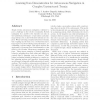Free Online Productivity Tools
i2Speak
i2Symbol
i2OCR
iTex2Img
iWeb2Print
iWeb2Shot
i2Type
iPdf2Split
iPdf2Merge
i2Bopomofo
i2Arabic
i2Style
i2Image
i2PDF
iLatex2Rtf
Sci2ools
IJRR
2010
2010
Learning from Demonstration for Autonomous Navigation in Complex Unstructured Terrain
Rough terrain autonomous navigation continues to pose a challenge to the robotics community. Robust navigation by a mobile robot depends not only on the individual performance of perception and planning systems, but on how well these systems are coupled. When traversing complex unstructured terrain, this coupling (in the form of a cost function) has a large impact on robot behavior and performance, necessitating a robust design. This paper explores the application of Learning from Demonstration to this task for the Crusher autonomous navigation platform. Using expert examples of desired navigation behavior, mappings from both online and offline perceptual data to planning costs are learned. Challenges in adapting existing techniques to complex online planning systems and imperfect demonstration are addressed, along with additional practical considerations. The benefits to autonomous performance of this approach are examined, as well as the decrease in necessary designer effort. Expe...
| Added | 28 Jan 2011 |
| Updated | 28 Jan 2011 |
| Type | Journal |
| Year | 2010 |
| Where | IJRR |
| Authors | David Silver, J. Andrew Bagnell, Anthony Stentz |
Comments (0)

